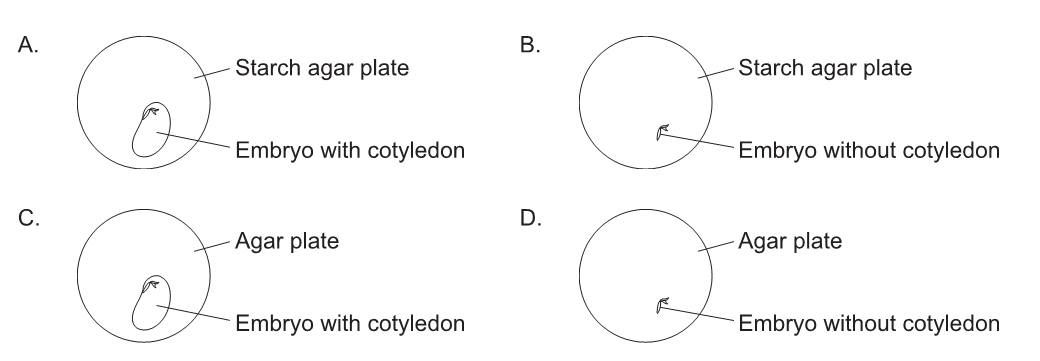IB Biology HL (HIGHER level)- 2024 – Practice Questions- All Topics
Topic 9.4 Reproduction in plants
Topic 9 Weightage : 8%
All Questions for Topic 9.4 – Plant Reproduction, Flowering, Flower Structure, Photoperiodism, Seed Structure, Germination, Monocots versus Dicots, Germination Stages
Question
Which method can be used to induce short-day plants to flower out of season?
A Grow them in winter
B Grow them in summer
C Expose them to a brief period of light during the night time
D Cover them with opaque cloth for several hours before sunset
▶️Answer/Explanation
Ans: D
I apologize for the confusion. The correct answer is D. Cover them with opaque cloth for several hours before sunset. This method can help to induce flowering in long-day plants, which require a certain amount of light to flower. Covering them with opaque cloth for several hours before sunset can create a longer period of darkness, which can help to promote flowering in long-day plants. Short-day plants require a certain amount of darkness to flower, so covering them with opaque cloth for several hours before sunset would not be effective in inducing flowering.
Agar is a growth medium without nutrients; starch agar is agar with starch added to it. Seed coats were removed from seeds and the seeds were used to set up the following conditions. Which plant embryo was unable to grow?

▶️Answer/Explanation
Markscheme
D
Cotyledons help supply the nutrition a plant embryo needs to germinate and become established as a photosynthetic organism, so without cotyledon the growth of seed is not possible. Starch can be used as a fuel to have growth in the seeds. So, without starch and without cotyledons growth of the seed is not possible. Such scenario is seen in figure D.
Which process is matched with a valid example?

▶️Answer/Explanation
Markscheme
B
Explosion of stamen would release pollen grains in the air and not seeds. Fertilization refers to the fusion of two nuclei, one from the male gamete (pollen grain) and another from ovule. The transfer of pollen grain by bees is called Pollination. Seeds when blown out from a flower in wind, it referred to as seed dispersal.
Which flower structures are indicated by the letters Y and Z?


▶️Answer/Explanation
Markscheme
D

In the given figure, X represents a part of female gametophyte, ovary and Y represents a part of male gametophyte, filament.
Chrysanthemums are an important commercial flower. As a short-day plant, how can growers induce chrysanthemums to flower out of season?
A. Expose plants to short bursts of light for 24 hours
B. Expose plants to 15 hours of continuous light
C. Expose plants to 12 hours of light and 12 hours of darkness
D. Expose plants to 15 hours of continuous darkness
▶️Answer/Explanation
Markscheme
D
The correct answer is D. Expose plants to 15 hours of continuous darkness. Chrysanthemums are short-day plants, which means they require a certain amount of darkness to flower. Therefore, growers can induce chrysanthemums to flower out of season by exposing them to a longer period of darkness than they would normally receive. This can be achieved by covering the plants with opaque cloth for 15 hours each day. Exposing the plants to short bursts of light for 24 hours (option A) or exposing them to 15 hours of continuous light (option B) would not be effective in inducing flowering in short-day plants. Exposing them to 12 hours of light and 12 hours of darkness (option C) would not be effective either, as this is the normal light cycle for chrysanthemums.
Question
Micropropagation is used to produce large numbers of plants in a short period of time. What is a feature of micropropagation?
A. Any tissue from a plant can be used for micropropagation.
B. The plants grown have different variations allowing for adaptations to the environment.
C. Micropropagation requires plant pollen and agar gel only.
D. The process is sterile and resulting plants are disease-free.
▶️Answer/Explanation

The correct answer is D. The process of micropropagation is sterile, which means that the resulting plants are disease-free. This is because the process involves growing plants from small pieces of plant tissue in a sterile environment, which prevents the growth of any pathogens that might be present. Any tissue from a plant cannot be used for micropropagation (option A), as only certain types of tissue, such as meristem tissue, can be used. Micropropagation does not involve plant pollen and agar gel only (option C), as it requires a variety of specialized equipment and supplies. The plants grown through micropropagation are genetically identical to the parent plant, so they do not have different variations (option B).
